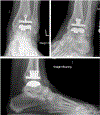Prospective Multicenter Study of Salto Talaris Ankle Arthroplasty With Minimum 4-Year Follow-Up
- PMID: 37902218
- PMCID: PMC10752572
- DOI: 10.1177/10711007231203678
Prospective Multicenter Study of Salto Talaris Ankle Arthroplasty With Minimum 4-Year Follow-Up
Abstract
Background: Total ankle arthroplasty (TAA) continues to be investigated as a primary treatment for end-stage ankle arthritis. The objective of this study is to report mid- to long-term results of the Salto Talaris TAA using prospectively collected patient-reported outcomes and implant survival rates with 4- to 13-year follow-up.
Methods: This was a retrospective study of prospectively collected data from 2 multicenter cohort studies from 3 centers. Three hundred fourteen subjects who received a Salto Talaris TAA from 2005 to 2015 were included in the study. Follow-up ranged 4-13 years following index procedure. Outcomes included 36-Item Short Form Health Survey (SF-36) mental and physical component summary scores, pain scores, and adverse events including additional surgeries, revision, or removal of components.
Results: Significant improvements were seen in pain and physical function scores at 2-year follow-up and were generally maintained through most recent follow-up. The survival rate of the prosthesis was >95% (n = 30/32 at >10 years, n = 272/282 at 4.5-10 years). Thirteen patients (4.1%) underwent revision or removal of their prosthesis. Time to revision ranged from 2 months to 6.5 years following the index procedure. Twenty-two patients (7.0%) had additional surgery that did not involve revision or removal of components.
Conclusion: Treatment of end-stage ankle arthritis with this implant provided patients with improved pain and functional outcome scores at mid- to long-term follow-up. The significant improvements reported at 2-4 years appeared to endure through the extended follow-up period.
Level of evidence: Level III, retrospective cohort study.
Keywords: Salto Talaris; ankle arthritis; total ankle arthroplasty; total ankle replacement.
Conflict of interest statement
Declaration of Conflicting InterestsThe author(s) declared the following potential conflicts of interest with respect to the research, authorship, and/or publication of this article: J. Chris Coetzee, MD, reports royalties or licenses from Arthrex, DePuy Synthes, Smith & Nephew, and Responsive Arthroscopy; consulting fees from Medtronic, and Smith & Nephew; payment or honoraria for lectures, presentations, speakers bureaus, manuscript writing or educational events from Smith & Nephew and Arthrex; and stock or stock options from Paragon and Responsive Arthroscopy. ICMJE forms for all authors are available online.
Figures





References
-
- Assal M, Kutaish H, Acker A, Hattendorf J, Lübbeke A, Crevoisier X. Three-year rates of reoperation and revision following mobile versus fixed-bearing total ankle arthroplasty: a cohort of 302 patients with 2 implants of similar design. J Bone Joint Surg Am. 2021;103(22):2080–2088. doi:10.2106/JBJS.20.02172 - DOI - PubMed
-
- Bates D, Maechler M, Bolker B, Walker S. Fitting lin-ear mixed effects models using Ime4. J Stat Softw. 2015;67(1):1–48.
Publication types
MeSH terms
Grants and funding
LinkOut - more resources
Full Text Sources
Medical
Research Materials

